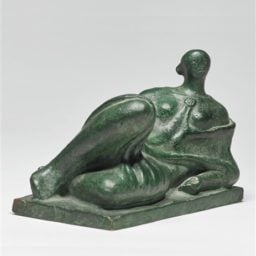Following her participation in the 2011 Venice Biennale, New York-based artist Carol Bove was invited by curator Pavel Pyś to make an exhibition for the Henry Moore Institute in Leeds. As a foil for her own work, she chose Venetian architect and designer Carlo Scarpa (1906–78), known for his great sensitivity to history, landscape, temporality, and materials.
The resulting exhibition, “Carol Bove / Carlo Scarpa”—first shown last autumn at Museion in Bolzano—pairs eight of Bove’s sculptures with a focused selection of Scarpa’s exhibition furniture, design prototypes, and sculptures.
While in Venice, Bove would have had the opportunity to view Scarpa’s work, most notably his inventive yet respectful renovation of the ground floor, garden, and entrance bridge the 16th century Palazzo Querini Stampalia and the meticulously designed Olivetti Showroom in Piazza San Marco, but also the Venezuelan Pavilion, a courtyard for the Italian Pavilion, and the ticket office, all in the Giardini of the Biennale.
Further afield in the Veneto is his monumental masterpiece, the Brion Tomb in San Vito d’Altivole near Treviso, as well as his renovation of the medieval Museo di Castelvecchio in Verona. Scarpa introduced modern elements in archaic settings and mixed base materials with precious ones.
A Rearrangement in Time
“Carol Bove / Carlo Scarpa” is arranged over three galleries and the reception area of the Henry Moore Institute. In the first gallery, Bove’s Untitled (Driftwood Bench) (2004), Coral Sculpture (2008), and Heraclitus (2014) are exhibited alongside two empty wood, metal, and glass museum vitrines and a wooden easel designed by Scarpa in the mid-1950s.

Carol Bove, For Asta (2014)
Installation view, Carol Bove/Carlo Scarpa, Museion Bolzano, ©Museion
Photo: Augustin Ochsenreiter Courtesy the Artist, Maccarone, New York and David Zwirner, New York/London
The grouping reveals a shared sensibility for materials and interest in devices of museological display, and also questions whether sculpture can be functional and design purely formal, without a use.
In a small gallery at the far end, an early Bove sculpture from 2003—featuring second-hand books, periodicals and artifacts dating largely from the 1960s arranged on mid-century modern, wall-mounted shelves—offers a counterpoint to Scarpa’s prototypes for the metal hardware of the Brion Tomb, including keys, locks, and candle holders, presented in one of the architect’s own vitrines.
The scale shifts dramatically in the middle gallery, where Bove has created a display for Asta, Contafili and Crescita, sculptures made by Scarpa for the 1968 Venice Biennale. As an architect and designer, Scarpa had traditionally devised settings for works by others, but here Bove takes on that task, designing a large platform, plinths, and hinged-steel armature for the three sculptures plus one of her own. The presentation, however, overpowers and neutralizes Scarpa’s sculptures, as does the white gallery space.

Carol Bove, Hysteron Proteron (2014)
Courtesy the Artist, Maccarone, New York and David Zwirner, New York/London
Bove’s re-evaluation of Scarpa succeeds not in this display of his sculptures but rather in her recent work. Doubling back to the reception area at the Institute, the visitor again encounters Hysteron Proteron (2014), a cast-concrete sculpture topped by a ziggurat inset with open cubes in gleaming brass that resemble a recurring motif from Scarpa’s oeuvre and embodies his talent for combining seemingly incongruous elements to produce a harmonious whole.
Its title, from the Greek for “latter first,” is a rhetorical device in which the rational or temporal order of two terms are reversed, an apt summation of Bove’s and Scarpa’s preoccupation with placing the plinth before the sculpture.
“Carol Bove / Carlo Scarpa” is on view at the Henry Moore Institute, 74 The Headrow, Leeds, UK, from April 2 -July 12.
(See Carol Bove’s and others’ tips for aspiring artists in 12 Must-Read Tips for a Successful Career in the Art World).
Follow Artnet News on Facebook:
Want to stay ahead of the art world? Subscribe to our newsletter to get the breaking news, eye-opening interviews, and incisive critical takes that drive the conversation forward.








